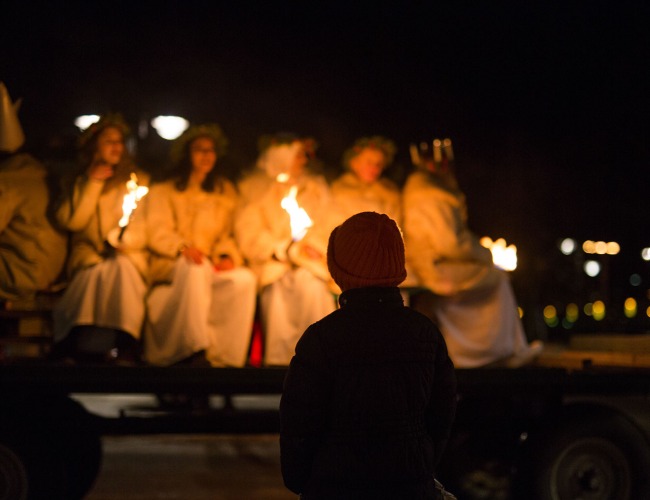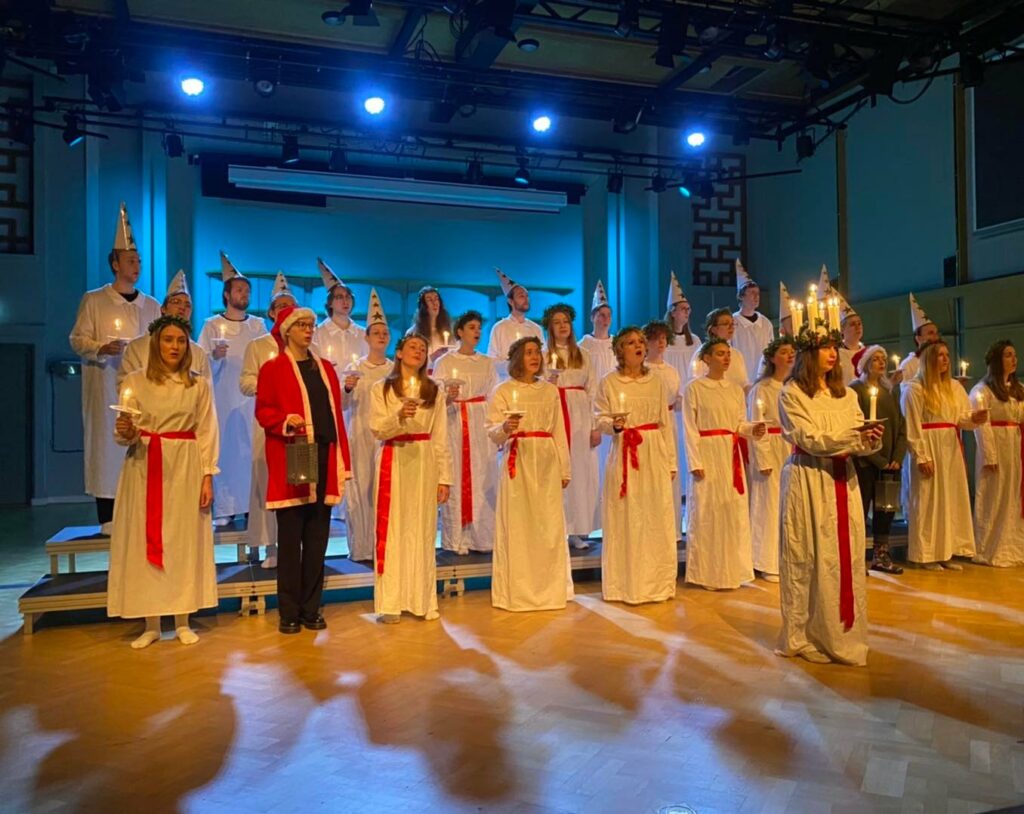This is probably often the image of a modern, Swedish Lucia celebration, where the procession is led by a Lucia and after her follow maids, boys with cone-shaped hats, gingerbread men and elves. Above all Lucia is characterized by the fact that she has a wreath of light on her head. Candles are traditionally used, but for safety reasons they are nowadays often replaced by battery-powered candles. The same applies to the candles that the maids carry in their hands. The maids usually wear glitter in their hair and glitter or a red ribbon around their waist. The boys wear all white – just like Lucia and the bridesmaids, and have cone-like hats and sticks with gold paper stars in their hands. The gingerbread men wear gingerbread costumes, and the elves wear red Santa outfits.
While the entourage slowly progresses, they sing beautiful, traditional songs, but sometimes also newly composed Christmas carols. In addition to spreading light and beautiful music in the winter darkness, Lucia also offers coffee and freshly baked “fika”, which usually consists of saffron buns and gingerbread. Classic Swedish pastries where the bun, a so called “Lussekatt”, is a saffron-scented, s-shaped wheat bun, and where the gingerbread cookies are baked as hearts, stars, pigs, horses, and in all imaginable shapes. The beverage usually consists of coffee and sometimes mulled and spiced wine, which is served with almonds and raisins in special small mugs.
Lussekatter are a tradition associated with Christmas and Lucia.
Saffransbröd i form av Lussekatter
If you visit Sweden in time to witness a Lucia celebration, you will be able to experience these in various public places, but also on TV, and radio. In many Swedish homes, people sit and watch this year’s Lucia celebration on TV (SVT2) at 7 AM or 6 PM on December 13. You can also watch it on SVT Play: https://www.svtplay.se/luciamorgon-fran-kalmar-slott
This year “Luciamorgon” is broadcast from Sala.
According to tradition, Lucia appears before dawn, but for practical reasons, many events are held at dusk, and don’t be surprised if the Swede next to you sings along – most Swedes know the Lucia song “Sankta Lucia” by heart.

Do you wish to attend a Lucia tradition in Arvika? In Arvika Lucia is crowned on December 13 at 7 pm at the Trefaldighets church and in several other churches in Arvika there are services with Lucia theme, see Arvika’s parish calendar.
On December 13, 12.15 pm, there is a Lucia celebration at Musikhögskolan Ingesund, and on December 17 at 7 pm students from the Estetiska skolan invite you to a traditional Lucia concert at the church in Brunskog. A different kind of luciacelebration can be experienced in Mangskog: On December 13th at 6 pm tractors decorated with lights start in Slobyn for a ride to the shop and back.

The story behind this old Nordic tradition
In the old farming society, December 13 was considered the longest night of the year.
Eventually, the Gregorian calendar was introduced, and the winter solstice then ended on December 21-22 instead. However, the custom that the night of December 13 was dangerous, full of supernatural beings, and needed to be illuminated to ward off darkness and evil forces was deeply rooted and still lived on.
When the Nordic countries were Christianized, the tradition of celebrating Lucia almost disappeared. It wasn’t until the 18th century that the Swedish people began to revive this custom. The church feared that the people of Northern Europe might revert to Norse paganism and the old traditions, viewing this as a threat. Saint Lucia, whose name somewhat resembled the term used for the tradition of spreading light during the Nordic winter nights, was chosen to convince the populace that Lucia was originally a Christian tradition.*
In western Sweden, Lucia Day was a day of celebration and was called “Little Christmas Eve” or “Lusse långnatt”. Those who could afford it ate large quantities of food, and in some places, people would have as many as three breakfasts.
*The legend of Saint Lucia tells the story of a woman named Lucia from Syracuse. According to the legend, her eyes were gouged out by Roman soldiers, and she was to be burned at the stake. However, through a miracle, her sight was restored, and the flames receded. This is said to have occurred on December 13.
In the Swedish Catholic calendar, Lucia was listed as a saint’s day until the 16th century, though it was not particularly celebrated. After the Reformation, when Sweden became Protestant, the religious significance of saints diminished.
